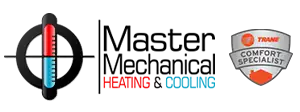Yes, Master Mechanical provides 24/7 emergency repair HVAC services. Whether you are a new or existing customer, if you are caught in the heat or the cold, give us a call at 847-722-0000 to contact our 24/7 emergency repair team.
Master Mechanical has been proudly servicing the community since 1980. We service our home location of Mount Prospect, in addition to Arlington Heights, Elk Grove Village, Buffalo Grove, Palatine, and the Northwest Suburbs. To read more about the areas we provide HVAC residential and commercial services, visit our dedicated Service Areas page.
Master Mechanical services both residential and commercial units. We are proud to provide installation, repair, and cleaning services for both heating and cooling systems. We also provide miscellaneous HVAC services, such as duct cleaning, air quality testing, and thermostat upgrades.
Master Mechanical is a small, family-owned and operated, local company based in Mount Prospect. We’re committed to dedicated and consistent service. We can even arrange for the same technician to help you every time you need service or preventative maintenance on your commercial or residential HVAC equipment. We understand how important it is to provide a personal relationship, so you know the person entering your home!
Additionally, as a member of the Comfort Club, you won't ever have to worry about scheduling regular maintenance. We know how busy life gets. Join the Comfort Club and we will contact you when your HVAC systems are due for an inspection.
You may wish to consider replacing your heating and air conditioning system if it is old, inefficient, or in need of repair. Today's systems are as much as 60% more efficient than those systems manufactured as little as ten years ago. In addition, if not properly maintained, wear and tear on a system can reduce the actual or realized efficiency of the system. If you are concerned about utility bills or are faced with an expensive repair, you may want to consider replacing your system rather than enduring another costly season or paying to replace an expensive component. The utility cost savings of a new unit may provide an attractive return on your investment.
If you have a qualified technician perform regular preventative maintenance and service suggested for your unit, industry averages suggest that an air conditioner should last 12-15 years and a gas furnace should last as many as 20-25 years. Read on for more frequently asked questions regarding an HVAC system upgrade.
A new HVAC system can vary greatly in price. There are many variables used to determine the cost of an upgrade, such as the size of your home and the type of unit. Master Mechanical also offers rebates and financing options. To receive a quote, schedule a consultation with our HVAC technicians.
The Energy Efficiency Ratio (EER) of a particular cooling device is the ratio of output cooling (in BTU/h) to input electrical power (in watts) at a given operating point. EER is generally calculated using a 95 °F outside temp and an inside (actually return air) temp of 80 °F and 50% relative humidity. The EER is a more realistic measurement of energy efficiency in warmer climates due to the high demand and higher cost of peak hour electricity.
The SEER rating of a unit is the cooling output during a typical cooling -season divided by the total electric energy input during the same period. The higher the unit's SEER rating, the more energy efficient it is. In the U.S., the SEER is the ratio of cooling in British thermal unit (BTU) to the energy consumed in watt-hours.
BTU, which stands for British Thermal Unit, is a measure of heat energy. One BTU corresponds to the amount of thermal (heat) energy required to heat one pound of water one degree Fahrenheit.
BTUs work in reverse, too. That is, a BTU measures the amount of energy required to lower the temperature of one pound of water one degree Fahrenheit. HVAC professionals use BTUs to measure the cooling capacity of an air conditioning system,. The higher the BTU measurement, the more powerful the air conditioner is.
Stage one is when the furnace is exerting its lowest heating capacity. In many cases, this may only be about 50 percent of what it's capable of producing. During stage one, the motor of the furnace is not running at full blast. Instead, a steady, but gentle airflow can be felt.
Stage two is when the furnace is giving its all and running at full blast. During stage two, the motors kick into high speed, forcing air through the ductwork and vents faster and with a stronger airflow.
The letters AFUE stand for “annual fuel utilization efficiency.” This is a rating that measures how efficiently your furnace, boiler, or water heater uses energy to provide you with a comfortable temperature.
Modern heating systems have high AFUE ratings. The US Department of Energy requires that all furnaces sold in the country must have an AFUE of at least 78%—and most electric and natural gas furnaces score higher than that. Boilers also are required to have high AFUE, and most new ones have AFUE of 85% or better. To help you grasp how efficient that is, consider that the AFUE of burning conventional firewood is only 45% to 55%!
